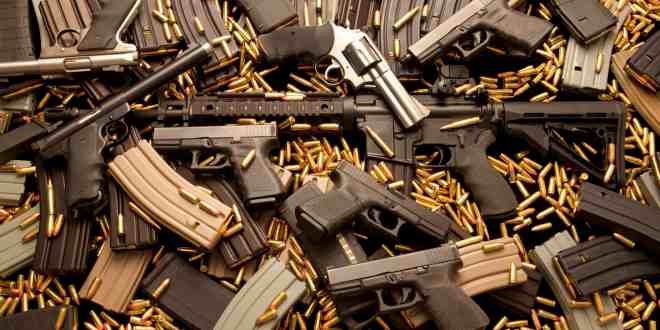Perhaps John T. Earnest might have been stopped by our new gun safety law from murdering Lori Gilbert Kaye in Poway, but it seems that the law would not have prevented Al Aliwi Al-Issa from massacring 10 people in Boulder.
Even Democratic leaders and the news media are heralding the new federal law with words like “sweeping,” “substantial” and “significant.” “Significant” is a relative word here. It will be “significant” if the law “significantly” slashes gun violence in America.
I hope it does, but after three decades I doubt if it accomplishes much. It will allow Republicans running in swing regions to assure rural and suburban voters that they are looking out for them. To dare to estimate numbers, I would be generous to predict a 5 percent dent in deaths and injuries caused by gun violence.
“It will probably do little for what happened here in Uvalde. It’s pretty modest,” said Texas state Sen. Roland Gutierrez on MSNBC on Saturday. Gutierrez daily decries the conditions that facilitated the shooting deaths of two teachers and 19 children at Robb Elementary School in Uvalde one month ago.
The law’s provisions are incredibly limited and in one sense racist. Signed into law by President Biden on Saturday morning, the legislation ignores shootings in urban neighborhoods where mostly African-Americans are gunned down.
New York, California, and Illinois have strong gun-safety laws on the books, but they lack the power to prevent the flow of guns through the “iron pipeline” from states with lax gun laws. From Indiana to Chicago’s South Side or Georgia and South Carolina to New York City.
A federal law requiring universal background checks could eventually reduce gun violence, yet Republicans refuse to consider it.
How can the new law be racist? Black people were targeted in Buffalo (N.Y.), Charleston (S.C.), and other mass shootings in which automatic weapons were employed. For that matter, Hispanics were targeted in El Paso. These mass shootings represented a type of killing spree in which a wide range of racial, religious and sex-oriented groups was affected.
But urban gun violence primarily causes the deaths of Black residents. Certainly whites and others are killed or wounded in urban gun violence, but anyone who lives in a large metropolis knows that the highest percentage of victims are Black. Philadelphia TV stations more often than not report on shootings in places like North Philadelphia, West Philadelphia and South Philadelphia, all Black communities, and the family-supplied photos of victims usually depict Black residents.
“We go to sleep to the sound of gunshots,” Cayla Waddington, an African high school student from West Philadelphia, said Sunday on ABC’s “Inside Story,” a Philadelphia public-interest program.
Can you imagine this pattern being lost on Republicans? What is their problem with vetting applicants for gun sales? The only people who will be denied gun purchases are those who are deemed likely to shoot innocent people. Responsible gun owners have nothing to worry about.
The Republicans’ refusal to vote for universal background checks boils down to a form of racism, even if it is not intended that way. They grudgingly consented to limits on background checks which are expected to apply to mass shootings at churches, grocery stores, movie theaters and schools where white suburbanites will probably be among the victims. On other issues, Republicans block legislation that will primarily serve the Black community and other racial minorities.
What are we supposed to make of these trends?
John Earnest may have been subject to the new law requiring authorities to review the juvenile and mental health records of gun purchasers under 21, perhaps preventing him from entering the Chabad of Poway synagogue three years ago where Lori Gilbert Kaye was murdered and other congregants were injured. He later pleaded guilty to her murder.
Earnest was 19 at the time, so that means he would be covered under the law.
But not Al Aliwi Al-Issa, who was 21 when he was apprehended in the murders of 10 people at the King Soopers grocery store in Boulder, Colo., on March 22, 2021. He was above the cutoff age under the law’s provision.
The bipartisan panel of senators who shaped this law considered increasing the age to purchase semiautomatic weapons from 18 to 21, but the senators settled on reviewing juvenile and mental health records of applicants.
Many killlers were far beyond the age range of Earnest and Al-Issa. The assailants in the Tree of Life synagogue massacre in Pittsburgh and the kosher grocery store in Jersey City were both in their mid-forties. That leaves plenty of time for would-be killers who will not be subject to the same level of review as those under 21.
We cannot dismiss the law’s expansion of mental health resources that would have presumably been available for Earnest and Al-Issa when they were students. How extensive these services would be under the law is not specified.
Academics who research gun violence voice doubt in a New York Times article that the MH clause will prevent much gun violence. The article states that it is “unlikely to result in fewer mass shootings or less interpersonal gun violence. More than half of gun deaths are suicides. Expanding access to mental health care might reduce firearms deaths, Dr. Swanson said, but mainly by preventing people from taking their own lives. Many people struggle with mental illness, and only a small percentage of them are violent.”
This passage refers to views of Jeffrey W. Swanson, a Duke University sociologist who has studied violence and mental illness for more than three decades.
Calling this legislation a law would be laughable if not for the dreadful nature of gun violence. It.is hardly a law when we consider its approach to the Red Flag laws. This “law” does not tell states to permit the temporary confiscation of guns from those deemed dangerous by a judge. Rather, we will spend $750 million to help states that create red flag laws, leaving each state to decide for themselves.
With this kind of logic, it will take another three decades to reduce gun violence by 10 percent.
Republished from San Diego Jewish World
























